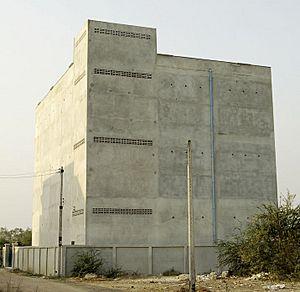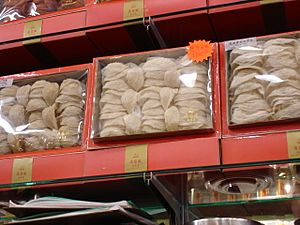Edible bird's nest facts for kids

Edible bird's nest
|
|
| Region or state | Southeast Asia and East Asia |
|---|---|
| Edible bird's nest | |||||||||||||||||||||||||||
|---|---|---|---|---|---|---|---|---|---|---|---|---|---|---|---|---|---|---|---|---|---|---|---|---|---|---|---|
| Traditional Chinese | 燕窩 | ||||||||||||||||||||||||||
| Simplified Chinese | 燕窝 | ||||||||||||||||||||||||||
| Literal meaning | "swallow nest" | ||||||||||||||||||||||||||
|
|||||||||||||||||||||||||||
Edible bird's nests are special nests made by certain types of swiftlet birds. These birds, like the edible-nest swiftlet, use their own hardened saliva to build their nests. People collect these nests to eat them. They are very popular in Chinese culture because they are rare, have a lot of protein, and taste rich.
These nests are one of the most expensive animal products people eat. They can cost a lot of money, sometimes thousands of dollars per pound! The price depends on the type of bird, and the nest's shape and color. Most nests are white, but some are red and are called "blood nests." In traditional Chinese medicine, people believe eating these nests is good for your health, especially for your skin. People have used bird's nests in Chinese cooking for over 400 years, often in a dish called bird's nest soup.
Contents
What is Bird's Nest Soup?
The most famous way to eat edible bird's nests is in bird's nest soup. This soup is a special delicacy in Chinese cooking. When you put the dried nests in water, they become soft and have a unique jelly-like texture. This texture is what people enjoy in the soup. Sometimes, it's served as a savory soup, and other times as a sweet soup.
Long ago, in the Qing dynasty in China, a cooking guide called the Suiyuan shidan said that bird's nest is a delicate ingredient. It shouldn't be cooked with strong flavors or oily foods. The guide also said that to truly enjoy its texture, you need to eat a good amount of it. Besides soup, bird's nests can be added to other dishes. They can be cooked with rice to make bird's nest congee (a type of porridge) or put into egg tarts and other desserts. You can also make a bird's nest jelly by steaming the nest with a little water and sugar.
How Bird Nests Are Collected

The nests that are collected the most come from the edible-nest swiftlet (also called the white-nest swiftlet) and the black-nest swiftlet. These nests are full of good things like protein. People traditionally believe they offer many health benefits. The nests are mostly made during the breeding season by male swiftlets. It takes them about 35 days to build a nest. The nests look like a shallow cup stuck to a cave wall. They are made from strong, sticky strands of the bird's saliva. Both types of nests have high levels of important minerals like calcium, iron, potassium, and magnesium.
In the past, people collected these nests from huge limestone caves, especially in places like Gomantong and Niah in Borneo. But as more and more people wanted the nests, new ways of collecting them appeared. Since the late 1990s, people started building special "nesting houses" for the swiftlets. These are usually concrete buildings designed like shop-houses in Southeast Asia. You can often find these nesting houses in cities near the sea, as swiftlets like to gather in those areas.
This has become a growing business in places like North Sumatra in Indonesia and Pak Phanang District in Thailand. Most of these nests are sent to Hong Kong, which is the main place for trading bird's nests around the world. This business is worth about HK$2 billion each year. Most of the people who buy these nests live in mainland China, which uses over 90 percent of all bird's nests. In some areas, the people who collect nests have noticed that there are fewer birds and more unexplained bird deaths.
Why Some Nests Are Red
Most bird's nests are white, but there are also red ones, known as "blood nests." These red nests are much more expensive. People used to think they had more medicinal value. A kilogram of white bird's nest might sell for up to $2,000, while a kilogram of red nests can cost up to $10,000!
For centuries, people wondered why some nests are red. It's not because they contain blood, as some stories say. Scientists found that the color comes from the environment where the nests are built. In 2013, researchers discovered that bird droppings (guano) in bird houses could turn white nests red. This suggests that things in the air inside caves or nesting houses cause the color change.
Later, a team of scientists in Singapore found that the redness is caused by gases in the air. These gases react with the proteins in the white bird's nest. This reaction creates a substance called 3-nitrotyrosine. If there's a lot of this substance, the nest turns a rich red color. If there's less, it can make the nests yellow, golden, or orange. The researchers also found that red bird's nests can absorb certain chemicals from the air, like nitrites and nitrates. These chemicals are sometimes linked to harmful compounds. This means that non-white bird's nests might contain substances that could be unhealthy for people to eat, so it's important to be careful.
The Bird's Nest Market
Indonesia is the biggest producer of bird's nests in Southeast Asia, exporting about 2,000 tons each year. Malaysia is next with 600 tons, and Thailand with 400 tons. The Philippines produces the least, around 5 tons per year.
In 2014, the bird's nest business made up 0.5 percent of Indonesia's total economy (GDP). This is about a quarter of what the country's fishing industry makes. In Thailand, the bird's nest trade, including both wild and "farmed" nests, is worth about 10 billion baht each year. Globally, the bird's nest industry is estimated to be worth around $5 billion.
Hong Kong and the United States buy the most bird's nests. In Hong Kong, a single bowl of bird's nest soup can cost between $30 and $100.
Fake Nests and How to Spot Them
Because bird's nests are so valuable, some people try to trick buyers by making fake nests or coloring white nests red. But scientists have found ways to tell if a nest is fake or has been changed. Real red cave nests are often found in limestone caves in Pak Phayun District, Thailand.
The high prices and demand have led to problems with fake nests. This even caused Malaysia to stop exporting nests to China for a while. To fight this, the Malaysian government now uses special RFID technology. This means they put tiny chips in the nests that store details about where they were collected, packaged, and transported. Scientists have also developed ways to check the quality of bird's nests in nesting houses in Sarawak, Malaysia.
Scientists use many advanced methods to check if bird's nests are real and good quality. They can use special microscopes and other tools to look at the nest's tiny parts. They also use DNA tests and protein tests to find out if other things, like white fungus, fish parts, or egg white, have been added to the nests. Each real bird's nest has a unique protein pattern that can be seen with these tests. These methods are simple to use, not too expensive, and very good at finding fake nests. They can even help tell where a bird's nest came from.
Rules for Bringing Nests into Countries
Since bird's nests are an animal product, some countries have strict rules about bringing them in. This is especially true because of concerns about bird diseases like H5N1 avian flu. For example, in Canada, bird's nest products that are already prepared, canned, and sterile are usually allowed. However, they might still have some import rules.
See also
 In Spanish: Nido comestible para niños
In Spanish: Nido comestible para niños





